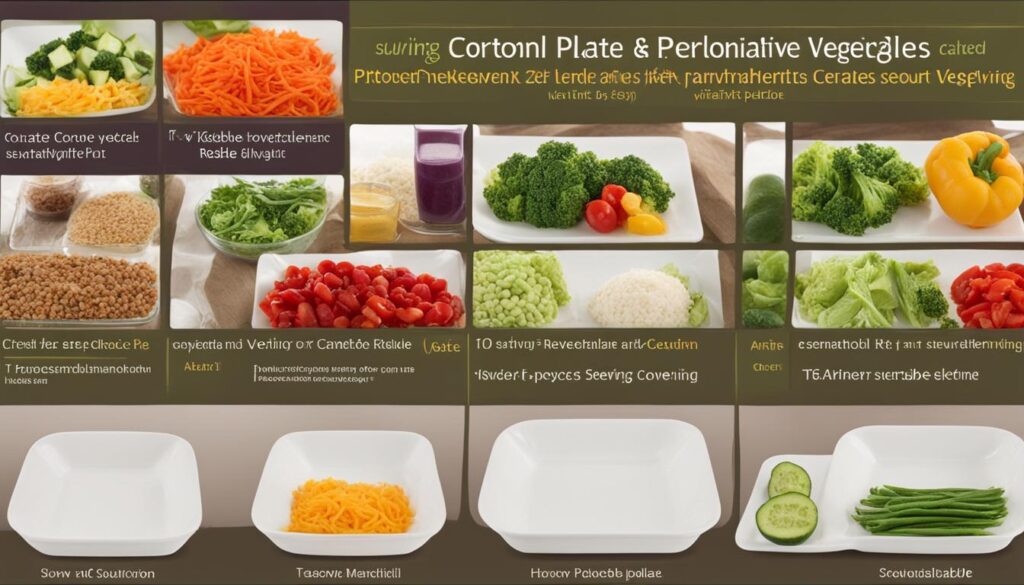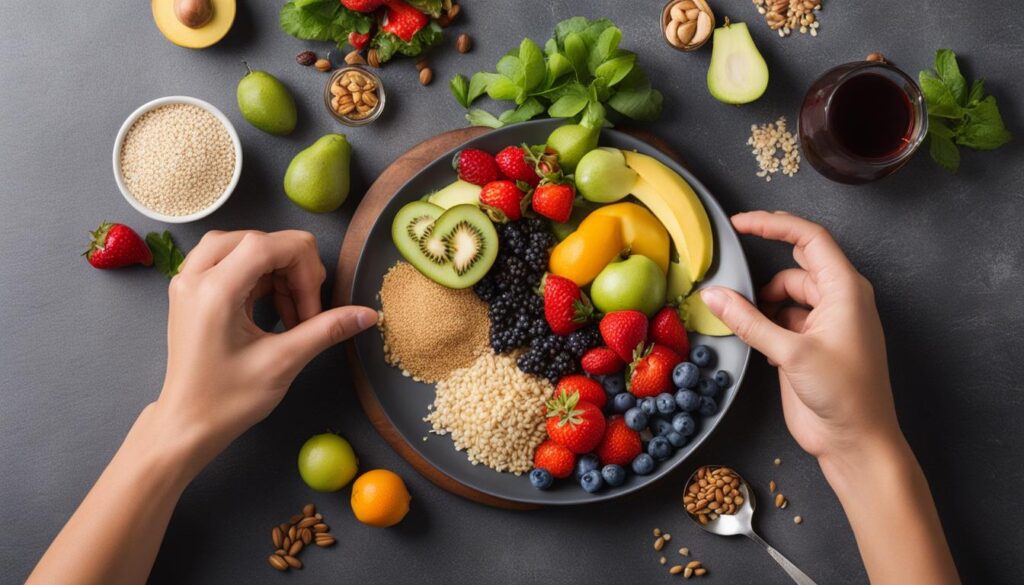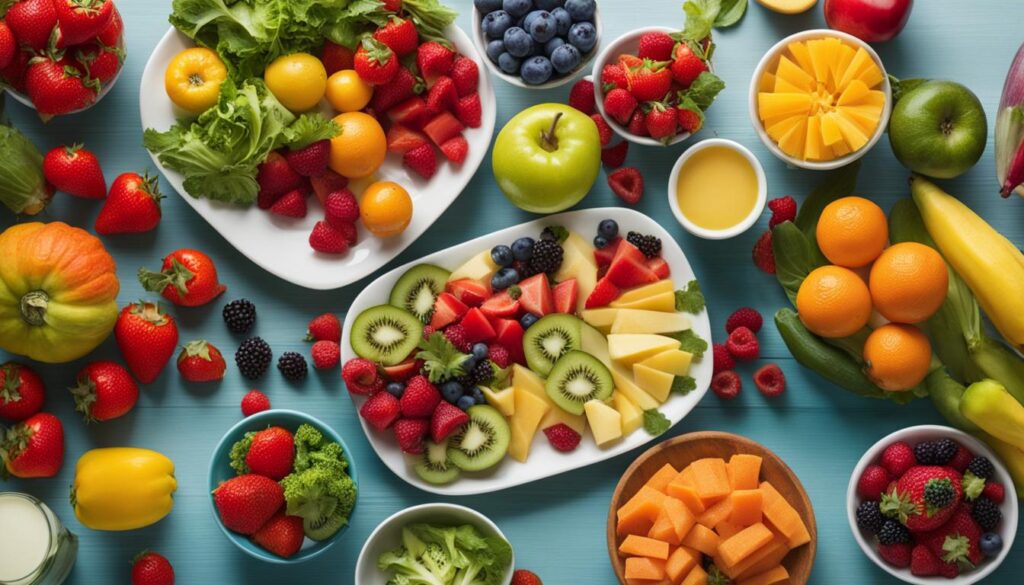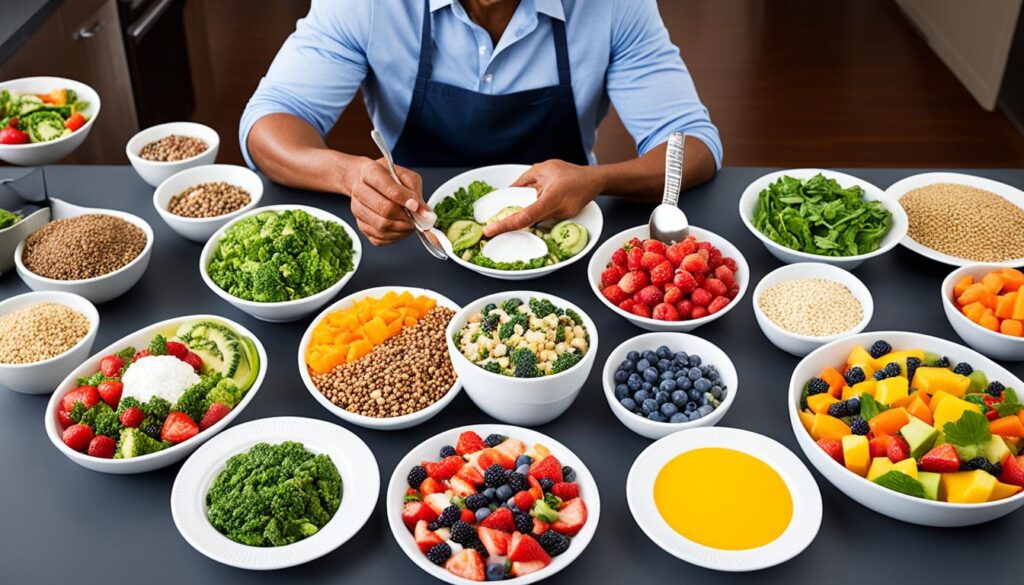Struggling to manage your weight and maintain a healthy lifestyle? Look no further! In this article, I will guide you on how to master sustainable portion control, allowing you to effortlessly achieve your weight management goals without feeling deprived. By adopting mindful eating habits, implementing portion control techniques, and focusing on balanced meal planning, you can finally bid farewell to crash diets and hello to sustainable weight loss.
Weight management is a common concern for many individuals. Whether you’re looking to shed a few pounds or maintain a healthy weight, portion control is the key to success. You don’t have to give up your favorite foods or drastically change your diet. With the right portion control strategies, you can still enjoy a variety of foods while managing your weight effectively.
Key Takeaways:
- Sustainable portion control is essential for effortless weight management.
- Mindful eating habits and balanced meal planning are key components of sustainable portion control.
- By mastering portion control techniques, you can achieve effective and sustainable weight loss.
- Implementing portion control strategies can help you maintain a balanced diet and manage your weight without feeling deprived.
- Start your journey towards sustainable portion control today and enjoy a healthier lifestyle.
Understanding the Basics of Portion Control
Portion control is a fundamental aspect of maintaining a balanced and nutrient-dense diet. It involves moderating the amount of food you eat at each meal or snack. But, it’s important to note that portion control is not about eating less; rather, it’s about eating the right amounts of the right foods.
For successful portion control, it’s crucial to understand serving sizes and how they align with your caloric and nutritional needs. By being aware of the appropriate portions, you can ensure that you’re fueling your body with the right nutrients without feeling deprived.
Let’s delve into the key elements of portion control.
- Serving sizes: Understanding serving sizes is essential for portion control. It helps you determine what a healthy portion looks like for different food groups. By following recommended serving sizes, you can maintain a well-balanced diet and ensure you’re providing your body with the right amount of nutrients.
- Caloric and nutritional needs: Each individual has specific caloric and nutritional needs based on factors like age, gender, weight, and activity level. It’s important to consider these needs when practicing portion control to ensure that you’re meeting the necessary nutritional requirements of your body.
By practicing portion control and being mindful of serving sizes and your caloric and nutritional needs, you can maintain a healthy and well-rounded diet without feeling restricted. Remember, it’s all about finding the right balance.

Benefits of Portion Control
Portion control offers several benefits, including:
- Helps in weight management and weight loss: By controlling portion sizes, you can manage your caloric intake and create a calorie deficit, which is essential for weight loss.
- Promotes balanced and nutrient-dense meals: Portion control allows you to include all the necessary food groups in your meals, ensuring that you’re getting a range of nutrients.
- Prevents overeating and mindless snacking: By being mindful of portion sizes, you can avoid overeating and mindless snacking on high-calorie foods.
- Aids in blood sugar management: Portion control can help stabilize blood sugar levels, reducing the risk of energy crashes and cravings for unhealthy snacks.
By embracing portion control as a part of your lifestyle, you can optimize your overall health and well-being.
The Role of Portion Control in Weight Loss
When it comes to weight loss, one of the most effective strategies is portion control. By regulating your calorie intake, portion control can help you achieve and maintain a healthy weight. Consuming more calories than your body needs leads to weight gain, while consuming fewer calories than you burn leads to weight loss.
Controlling your portions helps create a calorie deficit without drastic changes to your diet. It allows you to still enjoy the foods you love while ensuring you’re not overeating. By managing your portions, you can keep your blood sugar levels steady, which helps reduce cravings and prevents the urge to snack on high-calorie foods between meals.
Incorporating portion control into your lifestyle is a sustainable way to manage your weight. Instead of restrictive diets that may be hard to stick to, portion control focuses on moderation and balance. It allows you to enjoy a wide variety of foods while keeping your calorie intake in check.
The Calorie Deficit and Weight Loss
Weight loss occurs when you consume fewer calories than your body needs. This creates a calorie deficit, forcing your body to use stored fat for energy. Portion control helps you establish and maintain this calorie deficit by ensuring that you’re not overeating or consuming excess calories.
By controlling your portion sizes, you can easily manage your calorie intake and achieve sustainable weight loss. It’s important to be mindful of portion sizes and choose nutrient-dense foods that provide the necessary energy and nutrients your body needs to function properly.
“Portion control is about finding the right balance in your meals. By understanding how much food your body needs and managing your portions accordingly, you can achieve your weight loss goals while still enjoying your favorite foods.” – Jane Smith, Registered Dietitian
Steady Blood Sugar Levels and Prevention of Overeating
One of the benefits of portion control is the impact it has on your blood sugar levels. When you eat large portions or consume high-calorie foods, your blood sugar levels spike, leading to a crash later on. This can result in cravings and the urge to snack on unhealthy, high-calorie foods.
By practicing portion control and spreading your calorie intake throughout the day, you can keep your blood sugar levels stable. This helps prevent overeating, as stable blood sugar levels reduce cravings and the need for snacking on high-calorie foods between meals.
Implementing Portion Control Strategies
There are various strategies you can use to incorporate portion control into your daily routine:
- Use smaller plates and bowls to control portion sizes visually.
- Pre-portion snacks into individual servings to avoid mindless eating.
- Start your meals with vegetables to add volume and fiber while reducing calorie intake.
- Drink water before meals to create a feeling of fullness and prevent overeating.
- Eat slowly and mindfully to fully enjoy your food and recognize when you’re satisfied.
- Listen to your hunger cues and stop eating when you feel satisfied, not stuffed.
By incorporating these strategies into your daily routine and being mindful of your portion sizes, you can achieve effective and sustainable weight management.
| Benefits of Portion Control | Strategies for Portion Control |
|---|---|
|
|

The Science Behind Portion Control
Overeating is a common cause of weight gain, as it involves consuming more calories than your body needs for energy, resulting in a calorie surplus. This surplus leads to weight gain and can contribute to various health problems. That’s where portion control comes in.
Portion control helps regulate calorie intake by ensuring you consume the right amount of calories your body needs, creating a calorie deficit. This deficit is essential for weight loss, as it prompts your body to burn stored fat to make up for the energy shortfall. By managing portion sizes, you can control your calorie intake and achieve a calorie deficit, leading to gradual, sustainable weight loss.
However, portion control is more than just reducing the amount of food you eat; it’s about making smart food choices and focusing on balanced meals. Not all calories are created equal, so it’s important to select nutrient-dense foods that provide your body with essential vitamins, minerals, and macronutrients. By choosing balanced meals that include a variety of food groups, you ensure your body receives the necessary nutrients while managing portion sizes.
Understanding the science behind portion control is empowering. You can make informed decisions about your eating habits based on your specific goals and needs. By utilizing portion control techniques, you can effectively manage your weight and maintain a healthy lifestyle.
“Portion control isn’t about deprivation; it’s about finding the right balance between enjoying the foods you love and nourishing your body.” – Sarah Johnson, Registered Dietitian
The Role of Balanced Meals
One key aspect of portion control is prioritizing balanced meals. This means incorporating essential macronutrients – carbohydrates, proteins, and fats – in appropriate proportions during each meal. A balanced meal not only provides necessary nutrients but also helps you feel full and satisfied, reducing the temptation to overeat.
Here’s an example of a basic balanced meal:
| Food Group | Recommended Serving Size |
|---|---|
| Protein (e.g., chicken breast, tofu) | 3-4 ounces |
| Complex Carbohydrates (e.g., brown rice, whole wheat pasta) | 1/2 – 1 cup |
| Vegetables (e.g., broccoli, mixed greens) | 1-2 cups |
| Healthy Fats (e.g., avocado, olive oil) | 1-2 tablespoons |
By following these general guidelines and making smart food choices within each food group, you can ensure you’re providing your body with the necessary nutrients while managing portion sizes.

Remember, portion control is not about restriction or counting every calorie. It’s about finding a sustainable balance that nourishes your body and supports your weight management goals. By understanding the science behind portion control and prioritizing balanced meals, you can achieve long-term success in managing your weight and maintaining a healthy lifestyle.
Implementing Portion Control for Weight Loss
When it comes to achieving successful weight loss, implementing effective portion control strategies is essential. By adopting these strategies into your daily routine, you can create a healthy and balanced approach to eating. Here are some key strategies for implementing portion control:
- Understanding serving sizes: Familiarize yourself with appropriate serving sizes for different food groups. This will help you gauge the right amount of food to consume.
- Using smaller plates and bowls: Opt for smaller dishes when plating your meals. Research has shown that this can trick your mind into feeling satisfied with smaller portions, creating the illusion of eating more.
- Pre-portioning snacks: Divide snacks into individual portions ahead of time. This helps prevent mindless overeating and allows for better portion control.
- Starting with vegetables: Begin your meals with a generous portion of vegetables. They are low in calories and high in fiber, helping you feel fuller while consuming fewer calories.
- Drinking water before meals: Have a glass of water before your meals. This can help curb your appetite and prevent overeating.
- Eating slowly: Take your time and savor each bite. Eating slowly allows your brain to register when you feel full, preventing you from overeating.
- Listening to hunger cues: Pay attention to your body’s hunger and fullness signals. Eat when you are truly hungry and stop eating when you feel satisfied.
By incorporating these portion control strategies into your daily routine, you can achieve sustainable weight loss while still enjoying delicious and nutritious meals. Remember, it’s not about depriving yourself, but about finding a balance that works for you.

How Much is Enough: Serving Size Guidelines
| Food Group | Serving Size |
|---|---|
| Grains | 1 slice of bread ½ cup of cooked rice or pasta |
| Proteins | 3-4 ounces of meat, poultry, or fish ½ cup of cooked beans |
| Dairy | 1 cup of milk or yogurt 1.5 ounces of cheese |
| Fruits | 1 medium-sized fruit ½ cup of fresh, frozen, or canned fruit |
| Vegetables | 1 cup of raw or cooked vegetables 2 cups of leafy greens |
| Fats and Oils | 1 teaspoon of oil or butter 1 tablespoon of nut butter |
Portion Control When Eating Out
Maintaining portion control when eating out can be a challenge, especially when restaurants often serve larger portions. However, there are strategies you can use to navigate restaurant menus and stay on track with your weight management goals. By making healthy choices and practicing mindful eating, you can enjoy dining out while still maintaining portion control.
When perusing restaurant menus, it’s important to look for options that include plenty of vegetables. These dishes tend to be more filling and lower in calories, helping you stay within your portion control limits. Additionally, opting for lean proteins like grilled chicken or fish can provide a satisfying meal without excessive calorie intake.
It’s also crucial to be aware of hidden calories in sauces and dressings. Choose options that are lighter or ask for them on the side, allowing you to control the amount you consume. Another helpful tip is to avoid “supersizing” your meal. Instead, focus on ordering a regular-sized portion or sharing a larger dish with a dining companion.
Practicing mindful eating is key when dining out. Take your time to savor each bite, eating slowly and paying attention to your body’s hunger and fullness cues. This allows you to have a more enjoyable dining experience while also preventing overeating.
Sharing meals with others is another great way to manage portion control when eating out. Splitting an entrée or appetizer with a friend or family member can help you indulge in your favorite dishes without overeating. It also allows you to try a variety of items on the menu.
To-go boxes can be your best ally when it comes to maintaining portion control. If your meal comes in a larger portion than you need, don’t hesitate to ask for a to-go box and save the rest for later. This way, you can enjoy a satisfying meal while still managing your portion sizes.
Remember, maintaining portion control when eating out is all about making conscious choices and being mindful of your body’s signals. By implementing these strategies and practicing mindful eating, you can enjoy delicious meals at restaurants while still achieving your weight management goals.
| Portion Control Tips When Eating Out | Benefits |
|---|---|
| Choose meals with plenty of vegetables | – Higher satisfaction – Lower calorie intake |
| Opt for lean proteins like grilled chicken or fish | – Satisfying meal – Reduced calorie intake |
| Watch out for hidden calories in sauces and dressings | – Controlled calorie intake – Healthier options |
| Avoid “supersizing” and opt for regular-size portions | – Appropriate serving size – Balanced meal |
| Practice mindful eating and eat slowly | – Enjoyable dining experience – Prevent overeating |
| Share meals with others | – Opportunity to try various dishes – Controlled portion sizes |
| Request a to-go box for leftovers | – Portion control – Enjoy leftovers later |
Developing Sustainable Habits
Developing sustainable habits is crucial for long-term health and weight maintenance. When it comes to achieving and maintaining our weight goals, it’s not just about the short-term changes we make, but the long-lasting habits we develop. By implementing sustainable practices, we can ensure that we are taking care of our bodies and setting ourselves up for success.
One important aspect of sustainable habits is balancing macronutrients. Our bodies require a mix of carbohydrates, proteins, and fats to function properly. By incorporating these nutrients in balanced proportions, we can support our overall health and maintain our weight more effectively.
Plate size plays a significant role in portion control and sustainable eating. Using smaller plates can trick our minds into thinking we are consuming larger portions. This visual trick helps us feel satisfied while still managing our overall calorie intake.
“By making portion control a lifelong habit and celebrating progress, you can maintain a healthy lifestyle and manage your weight effectively.”
Mindful eating is another sustainable habit that promotes long-term health. Take the time to listen to your body’s hunger cues and eat slowly, savoring each bite. This practice allows you to be more in tune with your body’s needs and prevents overeating.
By adopting sustainable habits, we can achieve long-term success in weight maintenance and overall health. It’s not just about reaching a specific number on the scale; it’s about creating a lifestyle that supports our well-being.
Portion Control and Food Labels
When it comes to maintaining a balanced diet and practicing portion control, reading food labels is essential. Food labels provide valuable information about serving sizes and nutritional content, allowing you to make informed decisions about what and how much to eat.
By paying close attention to serving sizes listed on packaging, you can ensure that you are consuming the appropriate amount of food for your needs. Serving sizes act as a guide, helping you understand the recommended portions of different foods. This knowledge is crucial for portion control, as it allows you to manage your calorie intake and maintain a healthy weight.
“Food labels are like your health secret weapon. They empower you to take control of your eating habits and make choices that align with your goals.” – Nutrition Expert
In addition to serving sizes, food labels also provide detailed information about the nutritional content of different foods. This information includes the number of calories, fat, carbohydrates, protein, vitamins, and minerals present in a serving. By understanding the nutritional information, you can make conscious decisions about the types of foods you consume and ensure a well-rounded, balanced diet.
Here’s an example of how food labels can help with portion control:
| Food Item | Serving Size | Calories |
|---|---|---|
| Peanut Butter | 2 tablespoons | 190 |
| Bread | 2 slices | 180 |
| Banana | 1 medium | 105 |
By understanding the serving sizes and calorie content of these food items, you can easily determine how to incorporate them into your meals while maintaining portion control. For example, spreading 1 tablespoon of peanut butter on one slice of bread and adding a few banana slices can create a balanced and portion-controlled snack.
Remember, food labels are your guide to making informed choices and practicing portion control. By using this valuable tool, you can achieve your weight management goals and maintain a healthy lifestyle.
Conclusion
To achieve sustainable weight loss and maintain a balanced diet, mastering portion control is crucial. By understanding portion control techniques, practicing mindful eating habits, and implementing portion control strategies, you can effortlessly manage your weight and enjoy a healthy lifestyle.
One important aspect of successful portion control is balancing your meals. By ensuring that your plate includes a variety of nutritious foods, you can meet your body’s needs while controlling portion sizes.
Understanding serving sizes is another key component of portion control mastery. By being aware of recommended serving sizes and adjusting your portions accordingly, you can prevent overeating and maintain a healthy calorie intake.
Making smart food choices is also essential. Opting for nutrient-dense options and avoiding high-calorie foods can support your weight management goals and promote overall health and well-being.
By adopting these habits and consistently practicing portion control, you can achieve sustainable weight loss, maintain a balanced diet, and embrace a healthy lifestyle for years to come.
FAQ
What is portion control?
Portion control involves moderating the amount of food you eat at each meal or snack. It is not about eating less but about eating the right amounts of the right foods.
Why is portion control important for weight loss?
Portion control plays a vital role in weight loss by regulating your calorie intake. Consuming more calories than your body needs leads to weight gain, while consuming fewer calories leads to weight loss.
How does portion control help with weight management?
Portion control helps to maintain a balanced and nutrient-dense diet without feeling deprived. It also helps to keep your blood sugar levels steady, reducing cravings and preventing overeating and snacking on high-calorie foods between meals.
How can I implement portion control for weight loss?
Implementing portion control strategies is essential for successful weight loss. Understanding serving sizes, using smaller plates and bowls, pre-portioning snacks, starting meals with vegetables, drinking water before meals, eating slowly, and listening to hunger cues can all support portion control efforts.
How can I practice portion control when eating out?
When eating out, choosing meals with vegetables, opting for lean proteins, watching out for hidden calories in sauces and dressings, and avoiding “supersizing” can all help with portion control. Practicing mindful eating, eating slowly, and sharing meals with others are also effective strategies.
What other habits should I develop for sustainable weight management?
In addition to portion control, balancing macronutrients, adopting healthier eating habits, understanding the influence of plate size, and practicing mindful eating can all support sustainable weight management.
Why is reading food labels important for portion control?
Reading food labels is essential for understanding portion sizes and nutritional information. Paying attention to serving sizes listed on packaging helps you make informed decisions about the amount of food you eat and its nutritional content.


[…] these healthy snacking hacks into your daily routine can support sustainable fat loss and weight […]
[…] More control over portion sizes and nutrient […]